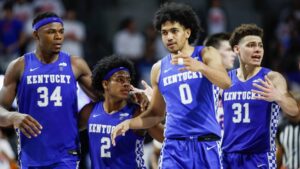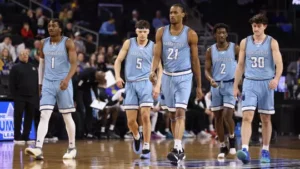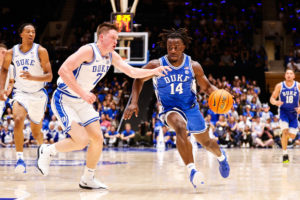
In the world of college basketball, few programs carry the weight of tradition, expectation, and scrutiny quite like the Duke Blue Devils. With a legacy built under the leadership of Mike Krzyzewski and continued into a new era under Jon Scheyer, Duke is not simply another blue blood—it is an institution. Each season is viewed not just through the lens of wins and losses but by how the team lives up to the legacy etched into the hardwood of Cameron Indoor Stadium. In the 2024–2025 season, expectations once again ran high, bolstered by a roster stacked with elite recruits, seasoned returners, and a promising coaching staff entering its formative years under Scheyer. Yet, amidst flashes of brilliance, this campaign was ultimately defined by one glaring mistake—a pivotal misstep that shaped not just the outcome of the season but cast doubt on the program’s direction moving forward.
The defining error of Duke’s 2024–2025 season was not a single missed shot, a turnover, or a late-game foul. It was a decision, strategic in nature, and indicative of a philosophical miscalculation: the over-reliance on a lineup lacking positional balance during critical stretches of the season. While Duke possessed an arsenal of talent, the coaching staff made a decisive gamble in leaning too heavily on small-ball lineups that sacrificed interior defense and rebounding for offensive fluidity. This decision became the Achilles’ heel of a season that could have—perhaps should have—culminated in a Final Four berth.
Coming into the season, Duke’s roster was headlined by a mix of five-star freshmen and veteran presences. Players like Caleb Foster, Jared McCain, and Sean Stewart were expected to be foundational pieces, while others such as Tyrese Proctor and Mark Mitchell brought experience and composure. The Blue Devils boasted versatility, capable shooters, and a high basketball IQ across the board. But despite having depth at the forward and center positions, Scheyer and his staff often opted for a guard-heavy lineup, emphasizing pace and perimeter play over post presence. The intent was clear: stretch defenses, push the tempo, and maximize spacing.
For a time, the strategy worked. Duke rattled off a strong start to the season, climbing into the top ten of national rankings and notching key non-conference wins that showcased their offensive prowess. The team moved the ball with precision, made shots in bunches, and looked like one of the most dangerous scoring teams in the country. Yet underneath the polish, cracks were forming. Opposing teams began to exploit Duke’s undersized lineups by attacking the paint and dominating the boards. Games that should have been comfortable wins turned into close affairs. Losses to more physically imposing teams began to pile up. The margins for error shrank.
The most painful manifestation of this mistake came during conference play. In a tightly contested ACC, Duke often found itself in battles against teams that excelled in physicality. Programs like North Carolina and Virginia made a point of attacking Duke’s interior, exposing the team’s lack of a consistent rim protector. Even lesser-ranked opponents found success crashing the offensive boards, earning second-chance points and stifling Duke’s transition game. This trend reached its boiling point during Duke’s ACC Tournament run, where their inability to match up physically cost them a shot at the title. The narrative shifted from championship aspirations to postseason survival.
It’s important to note that the Blue Devils had the personnel to counter this trend. Center Kyle Filipowski, one of the most talented big men in the country, was available for much of the season but was inconsistently featured in a true post role. Instead of anchoring the offense or defense in the paint, he was often positioned on the perimeter, attempting to stretch the floor rather than punish mismatches inside. While Filipowski’s versatility is part of what makes him an NBA prospect, his limited usage as a traditional big man further emphasized the absence of an interior presence. Similarly, promising freshman forwards saw limited minutes in key games, often replaced by guards playing out of position defensively.
The Blue Devils’ mistake was not one of talent but of philosophy. Scheyer’s commitment to small-ball and pace came at the expense of balance and physical dominance. In the biggest games of the season, Duke was repeatedly outmuscled and out-rebounded. The reliance on finesse over force rendered the team vulnerable against opponents willing to embrace physicality. The analytics may have supported the spacing and shooting advantages, but the results told a different story.
The NCAA Tournament laid bare the consequences of this miscalculation. After earning a respectable seed, Duke faced a physically imposing opponent in the Sweet 16 that exploited their interior weakness to devastating effect. Despite leading late in the second half, the opponent’s relentless offensive rebounding and inside scoring turned the tide. Duke could not answer with stops or rebounds, and the game slipped away. The season ended not in a blaze of glory, but in a quiet unraveling—a game lost not due to a lack of effort or talent, but due to a strategic error that was never fully corrected.
In hindsight, the course correction was available. Duke had the personnel to play bigger, to impose themselves in the paint, and to control tempo rather than constantly chasing pace. The coaching staff’s unwillingness—or inability—to adapt midseason cost the team crucial games. Adjustments came too late, and the cost was a season that promised so much but ended in disappointment.
Jon Scheyer now faces the critical task of learning from this mistake. Still early in his tenure, Scheyer has shown promise as a recruiter and a tactician. However, the 2024–2025 season will stand as a testament to the importance of adaptability and the dangers of rigid ideology. College basketball is defined by matchups, and the ability to exploit mismatches is what separates good teams from great ones. Duke had the opportunity to be great but settled into a comfort zone that prioritized style over substance.
This season’s mistake does not mean doom for the Blue Devils. In fact, it may be a necessary growing pain in the post-Krzyzewski era. The program remains a recruiting powerhouse, and the core of the team will likely return stronger and wiser. But the lesson must be learned: success in March is rarely won by one-dimensional teams. The best programs are those that can shift gears, assert their will, and adapt to the demands of the moment. Duke, for all its tradition and resources, fell short because it failed to adjust when it mattered most.
The 2024–2025 Duke Blue Devils were a team that at times looked capable of winning it all. They had talent, pedigree, and a fan base that never stopped believing. But seasons are not defined by potential—they are defined by execution. And in that critical moment when philosophy clashed with reality, Duke made the wrong choice. It was not a mistake born of laziness or incompetence but of misjudged confidence in a system that couldn’t withstand the physical demands of the postseason.
Now, as the program turns the page, the question remains whether this mistake will be a turning point or a cautionary tale. For Duke to reassert itself atop the college basketball hierarchy, it must remember that even the most talented teams can fall if they ignore the fundamentals of balance, adaptability, and toughness. In the unforgiving landscape of college basketball, one mistake can define a season—and for Duke in 2025, it did.





